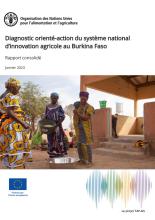Land Library
Welcome to the Land Portal Library. Explore our vast collection of open-access resources (over 74,000) including reports, journal articles, research papers, peer-reviewed publications, legal documents, videos and much more.
/ library resources
Showing items 1 through 9 of 81.Le diagnostic orienté-action du système national d'innovation agricole au Burkina Faso a été conduit conjointement par la FAO et le Ministère en charge de l'agriculture dans le but d'éclairer l'action politique à court terme tout en proposant un cadre stratégique global et de long terme pour renf
Context and background The mastery and control of rural areas remain a challenge for both landowners and the Burkinabe State.
Background and Context :Land is a key element for the practice of economic activities such as agriculture. In rural areas, its equitable access is an essential condition for sustainable development and the improvement of the living conditions of populations.
Vulnerability And Access To Land In The Commune Of Diama
Cambodia’s rain-fed and flooded rice fields are important and productive sources of inland fish and other aquatic animals, including frogs and snails. These aquatic resources are important to millions
Background: Economic reforms and trade liberalisation in Vaietnm have transformed the food environment, influencing dietary patterns and malnutrition status.
Inclusive community participation in bottom-up polycentric governance is at the heart of recognitional, procedural, distributional and inter-generational equity and of integrity of international, national and district-scale interventions to improve climate resilience in marginalized rural areas.
The Transforming Agrifood Systems in South Asia (TAFSSA) district agrifood systems assessment aims to provide a reliable, accessible, and integrated evidence base that links farm production, market access, dietary patterns, climate risk responses, and natural resource management with gender as a
The Transforming Agrifood Systems in South Asia (TAFSSA) district agrifood systems assessment aims to provide a reliable, accessible, and integrated evidence base that links farm production, market access, dietary patterns, climate risk responses, and natural resource management with gender as a



